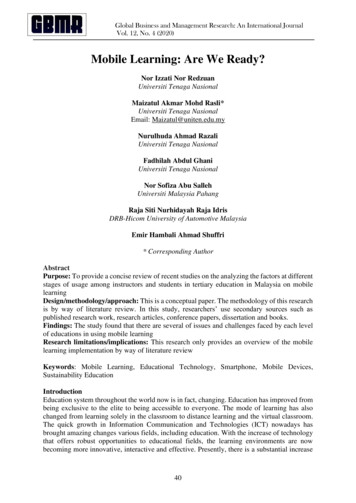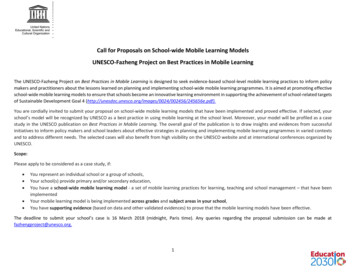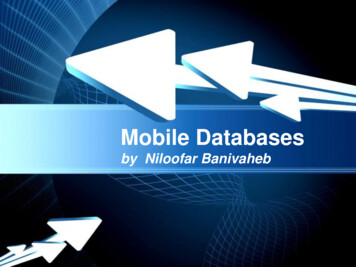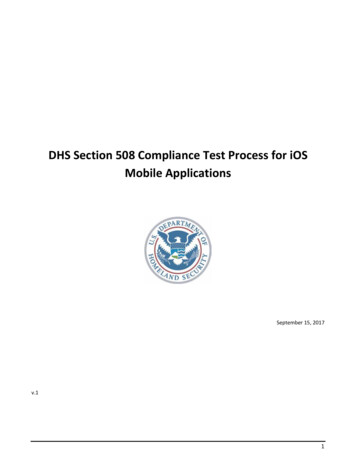
Transcription
Available online at www.sciencedirect.comProcedia - Social and Behavioral Sciences 00 (2011) 000–000Procedia - Social and Behavioral Sciences 30 (2011) 2477 – 2481ProcediaSocial diaWCPCG-2011What is Mobile Learning ? Challenges and CapabilitiesMasoud Hashemia *, Masoud Azizinezhad a , Vahid Najafia , Ali Jamali Nesari aaDepartment Of English , Toyserkan Branch , Islamic Azad University,Toyserkan , 6581685184,IranDepartment Of English , Toyserkan Branch , Islamic Azad University,Toyserkan , 6581685184,IrancDepartment Of English , Kangavar Branch , Islamic Azad University,Kangavar , 6581685184,IrandDepartment Of English , Ilam Branch , Islamic Azad University,Ilam , 6581685184,Iran1bAbstractThere are currently 1.7 billion mobile phones in use around the world, while the total world population is 6 billion (Keegan,2004).! In the past 10 years, the increasing development of mobile phone technology has been unbelievably swift: from fromplain and simple cell phones to the current high-tech phones which can serve as a PDA ,mini-computer, telephone, or camera,and transfer data as well as video and audio files. There is a constant stream of new technology breaking into the mobile phonemarket (Attewell, 2005). M-learning is the acquisition of any knowledge or skill through using mobile technology, anywhere,anytime (Geddes, 2004). M-learning happens when people are away from their offices or classrooms. On the way back homefrom school or office, most people prefer to listen to music, the radio news, or sports programs. When they get home, if theywant to learn, mobile devices are not likely to be their main choice. M-learning does not replace traditional learning, but is justanother way of learning using a new technology. This paper tries to show the capabilities as well as the limitations of M-(Mobile)Learning which generally fall into: Psychological , Pedagogical , Technical limitations . Ltd. Selection and/or peer-review under responsibility of the 2nd World Conferenceon Psychology, Counselling and Guidance.Keywords: M-Learning;1. IntroductionFor the first time E-learning emerged in the late 80s and in the 90s. Since then we have seen the processingpower of handheld devices grow exponentially while becoming more affordable and even ubiquitous due to thedemand for games, business communications, and in general the connected lifestyle of the wireless society. Thesethings have opened a new door to learning on the go which we now call M-Learning.Widespread ownership of mobile phones and the increasing availability of other portable and wireless deviceshave been changing the landscape of technology supported learning. Use of these technologies turns out to be wellaligned with strategic educational goals such as improving student retention and achievement, supportingdifferentiation of learning needs, and reaching learners who would not otherwise have the opportunity to participatein education (Kukulska- Hulme et al., 2005). A great deal of effort has also been devoted to understanding howmobile technologies relate to both traditional and innovative ways of teaching and learning, showing theapplicability of mobile learning across a wide spectrum of activity (Naismith et al., 2004; Kukulska-Hulme &Traxler, 2007) as well as highlighting the most important emerging issues (Sharples, 2006). Alongside formaleducation, everyday opportunities to access learning resources on mobile devices have multiplied. When making anonline booking for a foreign holiday or a flight, you might be offered a phrasebook to download to your audio player* Masoud Hashemi. Tel.: 98-918-851-2752; fax: 98-852-422-5353.E-mail address: masoudhashemi38@yahoo.com1877-0428 2011 Published by Elsevier Ltd. Selection and/or peer-review under responsibility of the 2nd World Conference on Psychology,Counselling and Guidance.doi:10.1016/j.sbspro.2011.10.483
2478Masoud HashemiHashemi /etProcediaal. / Procedia- Socialand BehavioralSciences30 (2011)2477 – 2481Masoud– Socialand BehavioralSciences00 (2011)000–000or mobile phone. When wishing to advance your knowledge of a language, it is possible to find downloadableresources and many websites that can be accessed on the go. In practice, there are issues of cost and usability thatoften stand in the way of such self-initiated mobile learning. The aims of this paper are to reflect on what mobilelearning has to offer and to consider whether it is likely to change how languages are taught and learnt. Educationalpractice is not determined by technology. Neither is technology likely to be a determining factor in informal,everyday learning. However, if we understand technology to be a social and cultural phenomenon, it “cannot butinfluence the ways in which people learn, and therefore what makes for effective learning and effective pedagogy”(Beetham & Sharpe, 2007: 6).1 . 1 What is Mobile Learning?According to Molenet, mobile learning can be broadly defined as 'the exploitation of ubiquitous handheldtechnologies, together with wireless and mobile phone networks, to facilitate, support, enhance and extend the reachof teaching and learning. Mobile learning can take place in any location, at any time, including traditional learningenvironments such as classrooms as well as in workplaces, at home, in community locations and in transit. Mobiletechnologies include mobile phones, smartphones, PDAs, MP3/ MP4 players (e.g. iPODs), handheld gamingdevices (e.g. Sony PSP, Nintendo DS), Ultramobile PCs (UMPCs), mini notebooks or netbooks (e.g. Asus EEE),handheld GPS or voting devices, and specialist portable technologies used in science labs, engineering workshops orfor environmental or agricultural study. Mobile learning involves connectivity for downloading, uploading and/oronline working via wireless networks, mobile phone networks or both, and linking to institutional systems e.g.virtual learning environments (VLEs) and management information systems (MIS).It is not the intention to provide in this paper an account of the field of mobile learning; in any case, the field hasalready grown and diversified to the extent that doing justice to it in a brief overview is now becoming close toimpossible. A number of publications offer general orientations and reflections on progress that are suitable formobile learning researchers and practitioners alike (Naismith et al., 2004; Kukulska-Hulme & Traxler, 2005;Naismith & Corlett, 2006; Faux et al., 2006; Sharples, 2006; Kukulska-Hulme et al., 2009). In this section, we willfocus on some points that are essential for understanding mobile learning. There is no agreed definition of „mobilelearning‟, partly because the field is experiencing rapid evolution, and partly because of the ambiguity of „mobile‟ –does it relate to mobile technologies, or the more general notion of learner mobility? In fact both aspects arecurrently important; in addition, the mobility of content is often highlighted. Mobility needs to be understood notonly in terms of spatial movement but also the ways in which such movement may enable time-shifting andboundary-crossing (see Traxler, 2009, for a discussion of definitions of mobile learning; see Kakihara & Sørensen,2002, for an analysis of mobility). In the future, when technology is an integral part of our surroundings, it ispredicted that we will no longer have to carry a mobile device. Even now, learners tend to move between usingdesktop computers and mobile devices, and maybe touch-screen displays in public areas, often for different parts ofa learning task. Interactions mediated by technology are interspersed with direct interactions with people. Thelearner‟s mobility creates an ever-changing environment for learning: the mobile technology, while essential, isonly one of the different types of technology and interaction employed. The learning experiences cross spatial,temporal and/or conceptual borders and involve interactions with fixed technologies as well as mobile devices.Weaving the interactions with mobile technology into the fabric of pedagogical interaction that develops aroundthem becomes the focus of attention.(Kukulska-Hulme et al., 2009: 20)It is possible to claim that the devices learners use are hardly relevant; what is important is the notion of mobilityand the construction of learning conversations in that process. Any discussion focusing on the primacy oftechnology is then liable to be perceived as a techno-centric perspective on education. However, anyone whobecomes involved in mobile learning will quickly notice that at the present time, it really matters which deviceslearners are using. First, ownership of the device makes a difference, since a tool that has only been borrowed maynot be used in the same way as one that is owned and very familiar. Second, learners who have more than onedevice are likely to behave differently from those who only have one, because the former can more easily overcome2
MasoudHashemiet al. // ProcediaProcedia –- Social– 2481MasoudHashemiSocial andand BehavioralBehavioral SciencesSciences 3000 (2011)(2011) 2477000–0002479common problems of short battery life and reliability. Third, particular mobile devices have strong associations withspecific realms of activity, be it work-related or for leisure. If I own a Nintendo DS, designed for games, then onecourse of action open to me is to look for language learning games I might play on that device. The availabletechnology influences my learning choices. The association between mobile learning and mobile gaming is in factalready strong and it appears to be getting stronger. A publication targeting Dutch teachers, prepared by Smidts,Hordijk & Huizenga (2008) highlights the potential for playful and creative use of GPS (global positioning system)and mobile technology in education, and many of the examples given are learning games. The authors note that GPScan give “an additional dimension” to mobile learning: New possibilities emerge when a pupil starts learning with amobile device with GPS functionality. Via satellites the GPS receives signals that indicate the position of the pupilwith the device. On the basis of this position the pupils can receive location-specific information on their devices, oradd this information. In this manner a connection will be formed between the physical and the virtual worlds inwhich the pupils find themselves; several layers of information are accessible at the same time (Smidts, Hordijk &Huizenga, 2008:4).1.2 Why Use Mobile Devices For Learning?Most mobile devices are useful in education as administration, organization and teaching aids for practitioners,and also as learning support tools for learners. Here are some of the main benefits: Learners can interact with each other and with the practitioner instead of hiding behind large monitors. It's much easier to accommodate several mobile devices in a classroom than several desktop computers. PDAs or tablets holding notes and e-books are lighter and less bulky than bags full of files, paper andtextbooks, or even laptops. Handwriting with the stylus pen is more intuitive than using keyboard and mouse. It's possible to share assignments and work collaboratively; learners and practitioners can e-mail, cut, copyand paste text, pass the device around a group, or 'beam'? the work to each other using the infrared function of aPDA or a wireless network such as Bluetooth. Mobile devices can be used anywhere, anytime, including at home, on the train, in hotels - this isinvaluable for work-based training. These devices engage learners - young people who may have lost interest in education - like mobilephones, gadgets and games devices such as Nintendo DS or Playstation Portable. This technology may contribute to combating the digital divide, as this equipment (for example PDAs) isgenerally cheaper than desktop computers.However, you may also need to consider the following potential disadvantages: Small mobile and PDA screens limit the amount and type of information that can be displayed. There are limited storage capacities for mobiles and PDAs. Batteries have to be charged regularly, and data can be lost if this is not done correctly. They can be much less robust than desktops (although tablet PCs are beginning to tackle this problem). It's difficult to use moving graphics, especially with mobile phones, although 3G and 4G will eventuallyallow this. It's a fast-moving market, especially for mobile phones, so devices can become out of date very quickly. Bandwidth may degrade with a larger number of users when using wireless networks.What can we do with m-learning?1.Access documets or document libraries2.Access quizes and self-assessment as question or games3.Prticipate in lessons and tutorials4.Receive lectures archived or broacasted live5.Access to video clip or audio libraries6.Read asynchronous postings7.Exhibit student work8.Participate in virtual learning communities on the go3
2480Masoud HashemiHashemi /etProcediaal. / Procedia- Socialand BehavioralSciences30 (2011)2477 – 2481Masoud– Socialand BehavioralSciences00 (2011)000–0001 . 3 The Technology Of M-Learninga) SMS: Short Message Service allows users to send/receive messages of up to 160 characters betweenmobile phones (text messaging).b) MMS: Multimedia Messaging Service serves the same purpose as SMS but allows the inclusion ofgraphics.c) WAP: An international protocol that allows users to access the internet via their WAP enabled mobilephones.d) GPRS: An always on internet connection for mobile devices that provides greater speed of connection(171kb/s).e) Bluetooth: A short range wireless connection. This enables PDAs (Personal Digital Assistants) to passmessages to and from other mobile devices.f) 3G and 4G phones: By the end of the decade 4G (4th Generation mobile phones) will provide upto 100megabits per second transmissions adequate for multimedia.g) PDAs: Personal Digital Assistants have evolved to mini PCs able to carry out many of the basic functionsof a larger PC using the Palm OS or MS Pocket PC operating system.h) MP3s: Audio file format that efficiently compresses files and enables them to be shared.i) CAMs: Video cameras now embedded into mobile phone and PDAs.1. 4 The Availability Of M-LearningThe size, shape, weight and portability of mobile devices make them particularly effective for users withdisabilities. The organizer functions usually included in mobile devices are extremely useful for learners withlearning difficulties to help them organize their lives and achieve some independence. PDAs often also incorporatedictionaries and thesauruses, which provide handy reference tools for learners with dyslexia or other learningdifficulties. Tablet PCs include text-to-speech and voice recognition as standard tools, which are valuable for userswith disabilities or learning difficulties. The devices can also be attached to wheelchairs with the use of smallbrackets.1. 5 Benefits Of M-Learninga) Interaction: Student interaction with instructors and among each other.b) Portability: PDAs are lighter than books and enable the student to take notes or input data directly into thedevice regardless of location either typed, handwritten or using voice.c) Collaborative: Enables several students work together on assignments even while at distant locations.d) Engaging learners: The new generation likes mobile devices such as PDAs, phones and games devices.e) Increase motivation: Owner ship of the handheld devices seems to increase commitment to using andlearning from it.f) Bridging of the digital divide: Since handhelds are more affordable than larger systems they are accessibleto a larger percentage of the population.g) Just-in-time learning: Increases work/learning performance and relevance to the learner.h) May assist learners with some disabilities.1. 6 Disadvantages Of M-Learning Deviceso Small screens of mobile phones and PDAso Limited storage capacities in PDAso Battery life/chargeo Lack of common operating systemo Lack of common hardware platform make it difficult to develop content for all.o Less robust4
MasoudHashemiet al. // ProcediaProcedia –- Social– 2481MasoudHashemiSocial andand BehavioralBehavioral SciencesSciences 3000 (2011)(2011) 2477000–000ooooo2481Still difficult to use moving graphicsLimited potential for expansion with some devicesDevices can become out of date quicklyWireless bandwidth is limited and may degrade with a larger number of usersDifficulties with printing, unless connected to a network2. ConclusionMobile learning is currently the most useful tool in ICT world. It is believed that mobile learning could be aessential factor in involving young adults in learning, where more traditional methods have failed. As mobilephones combine PDA functions with cameras, video and MP3 players, and as tablets combine the portability ofPDAs with the functionality of desktops, the world of learning becomes more mobile, more flexible and moreexciting. What makes mobile technology so intriguing is that it has an affinity with movement between indoors andoutdoors, across formal and informal settings, allowing learners to lead at least some of the way. If languagelearners‟ preferences and needs can be allowed to have a bearing on what is learnt and how, mobile technologieshave a clear role to play in realizing such an objective. Mobile technology takes learning out of the classroom, oftenbeyond the reach of the teacher. This can be perceived as a threat, so the challenge is to develop designs that clearlyidentify what is best learnt in the classroom, what should be learnt outside, and the ways in which connectionsbetween these settings will be made.ReferencesBeetham, H. & Sharpe, R. (eds) (2007) Rethinking Pedagogy for a Digital Age:Designing and Delivering E-Learning. London: Routledge.Donaldson, R.P. & Haggstrom, M.A. (2006) (eds) Changing Language Education Through CALL. Routledge Studies in Computer AssistedLanguage Learning. London: Routledge.Fallahkair, S., Pemberton, L. & Griffiths, R. (2007) Development of a cross-platform ubiquitous language learning service via mobile phone andinteractive television. Journal of Computer Assisted Learning, 23 (4), 312-325.Faux, F., McFarlane, A., Roche, N. & Facer, K. (2006) Handhelds: learning with handheld technologies. Handbook for dbooks/05 01.htmKakihara, M. & Sørensen, C. (2002) Mobility: An Extended Perspective. In Proceedings of the 35th Hawaii International Conference on SystemSciences (HICSS- 35). IEEE, Big Island, Hawaii. 7th-10th January 2002, 1756- 1766.Kukulska-Hulme, A., Sharples, M., Milrad, M., Arnedillo-Sánchez, I. & Vavoula, G.(2009) Innovation in Mobile Learning: A EuropeanPerspective. International Journal of Mobile and Blended Learning, 1(1), 13-35, January-March 2009.Kukulska-Hulme, A. & Traxler, J. (2007) Designing for mobile and wireless learning. In Beetham, H., & Sharpe, R. (eds) (2007) RethinkingPedagogy for a Digital Age: Designing and Delivering E-Learning. London: Routledge.MANOLO project (2006) Project website. Deliverables - case studies. es/cases.aspNaismith, L., Lonsdale, P., Vavoula, G. & Sharples, M. (2004) Literature Review in Mobile Technologies and Learning. FutureLab Report /lit reviews/Mobile Review.pdf.Pettit, J. & Kukulska-Hulme, A. (2007) Going with the Grain: Mobile Devices in Practice. Australasian Journal of Educational Technology(AJET). 23(1), 17-33. Sharples, M. (Ed.) (2006) Big issues in mobile learning. Report of a workshop by the Kaleidoscope Network of Excellence Mobile LearningInitiative, University of Nottingham, UK.Traxler, J. (2009) Learning in a Mobile Age. International Journal of Mobile and Blended Learning, 1(1), 1-12, January-March 2009. Valdivia,R., & Nussbaum, M. (2007). Face-to-Face Collaborative Learning in Computer Science Classes. International Journal of EngineeringEducation, 23(3), 434- 440.5
1 . 1 What is Mobile Learning? According to Molenet, mobile learning can be broadly defined as 'the exploitation of ubiquitous handheld technologies, together with wireless and mobile phone networks, to facilitate, support, enhance and extend the reach of teaching and learning. Mobile learning can take place in any location, at any time .










